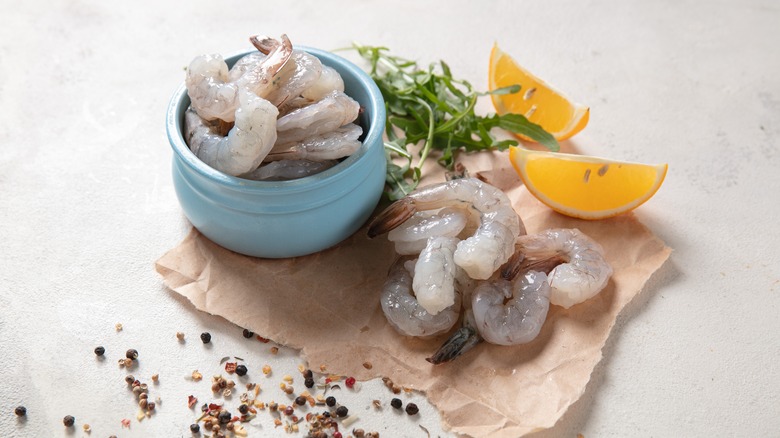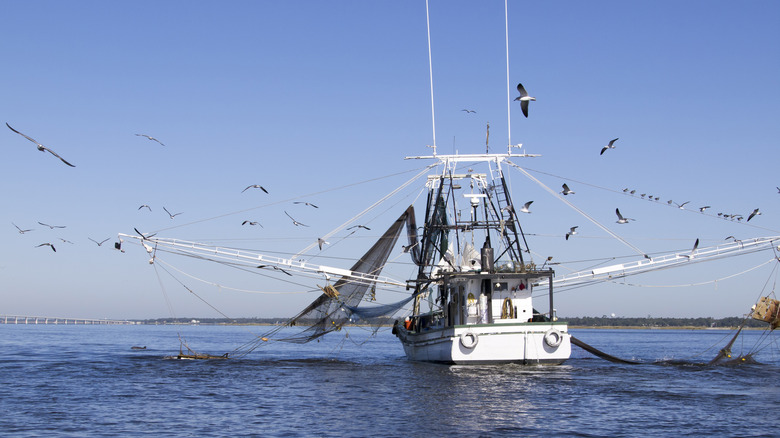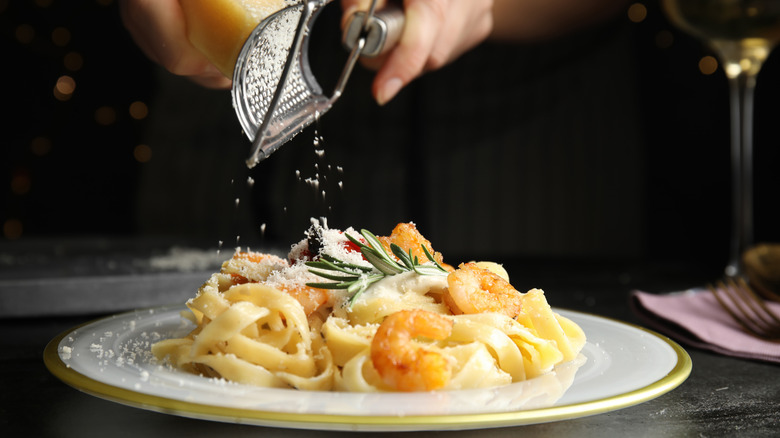The Chemical Risk Behind Imported Shrimp (And How To Curb It)
If you wanted a reason to feel patriotic you might extrapolate one from the many reports urging consumers to choose domestic shrimp over imported. Taken at face value, the health reasons are staggering. WebMD shares that shrimp is considered a healthy source of protein and contains antioxidants and minerals to boost nutrition. Domestic shrimp, however, just might be safer. Environmental advocates might also cheerlead for the domestic wild-caught varieties.
Buckle up — by the time we're done, you may be craving a garlicky, buttery-baked shrimp dish or maybe a bacon-wrapped shrimp kebab. You might also be whispering to yourself, over a briny, fresh pile of delicious crustaceans, "America."
Domestic shrimp are usually wild-caught since farmed shrimp have so much competition from cheaper varieties sourced overseas, but the reasons to choose American go beyond rooting for the home team. When it comes to staying safe, a laundry list of reasons to eat domestic — either wild-caught or farmed — has been building over time. American shrimp is often subject to strict regulations and standards which do not exist in other countries. Despite this advice, Americans eat over four pounds of shrimp per year on average, and much of that consumption is of the imported type.
Shrimply the best
The public is said to worry about the transmission of toxic chemicals in their seafood, and for good reason. For example, oil and plastics spills, such as the 2010 Deepwater Horizon spill and domestic Formosa plastic water pollution beginning in 2016 have affected the Gulf of Mexico. However, shrimp sold by American fishermen and from U.S. waterways are safe by Food and Drug Administration standards. And even though Scientific American reports on those who say the Environmental Protection Agency may disagree on safe levels of mercury and polycyclic aromatic hydrocarbons (PAHs), only testing of the so-called "edible portion" of shrimp muscle tissue versus head and guts — which some people do eat — domestic shrimp is often still a better bet. This is because domestic aquacultured shrimp is subject to lots of regulations, both environmental and for tracking and other purposes. Shrimp from other countries, usually farmed, is often not.
If what we hear from Consumer Reports is true, the FDA tests a tiny percentage of imported shrimp, prompting Johns Hopkins to call the testing "inadequate" in 2011. Consumer Reports adds that farmed shrimp from overseas uses antibiotics. Those antibiotics can often contribute to drug-resistant strains of bacteria like MRSA. The New York Times reports that hormones and steroids are also used in imported fish.
Getting dirty vs eating clean
Bloomberg reports that some overseas farms may also be just plain dirty, with bacteria growing rife without strict standards. Inspected imports find that shrimp often have bacteria that would come from human handlers who are also not practicing strict cleanliness standards, according to Consumer Reports.
American fish farmers do not generate reports of bacteria the way shrimp from overseas does. Additionally, wild-caught domestic shrimp do not have the confines of a large-scale operation to make them dirty. These wild shrimpers have supported generations of shrimp catchers and even though the shrimpers are sometimes seeing smaller areas to catch due to the shrinking habitats, sustainability is an important aspect. EatingWell describes four sustainable domestic wild-caught shrimp varieties to look for. Those closest to the areas they come from enjoy the best flavors from food that has traveled the shortest distance and is responsibly caught. EatingWell mentions "pink shrimp from Oregon (a Seafood Watch best choice); spot prawns from the Pacific Northwest; brown, white and pink shrimp from the Gulf of Mexico (except Louisiana); and any shrimp from U.S. and Canadian waters in the northern Atlantic."
Essentially, the reasons to buy American are too large to ignore. The next time you want shrimp, think about where it comes from. It could mean a big difference in food health and safety. From antibiotics to steroids and hormones, your fish might be a lot cleaner when it's domestic. The environment thanks you too.


